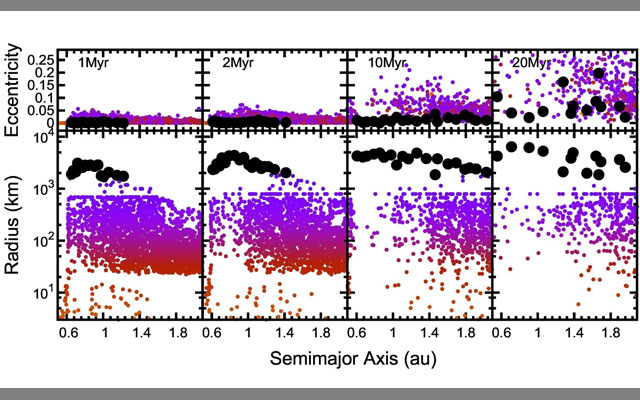
Supercomputer Simulations Showcase Novel Planet Formation Models
SDSC’s ‘Comet’ used to explore the possibility of earth-like planets in other solar systems
Published Date
By:
- Kimberly Bruch
Share This:
Article Content
Most of us are taught in grade school how planets formed: dust particles clump together and over millions of years continue to collide until one is formed. This lengthy and complicated process was recently modeled using a novel approach with the help of the Comet supercomputer at the San Diego Supercomputer Center on the UC San Diego campus.
The modeling enabled scientists at the Southwest Research Institute (SwRI) to implement a new software package, which in turn allowed them to create a simulation of planet formation that provides a new baseline for future studies of this mysterious field.
“Specifically, we modeled the formation of terrestrial planets such as Mercury, Venus, Earth, and Mars,” said Kevin Walsh, SwRI researcher and lead author of Planetesimals to terrestrial planets: Collisional evolution amidst a dissipating gas disk published in the Icarus Journal. “The problem of planet formation is to start with a huge amount of very small dust that interacts on super-short timescales (seconds or less), and the Comet-enabled simulations finish with the final big collisions between planets that continue for 100 million years or more.”
What’s Out There? And Who?
As Earthlings, these models give us insight into the key physics and timescales involved in our own solar system, according to the researchers. They also allow us to better understand how common planets such as ours could be in other solar systems. This may also mean that environments similar to Earth may exist.
“Part of this puzzle is to understand how the ingredients of life, such as water, made their way to Earth,” said Walsh. “One big consideration is these models traced the material in the solar system that we know is rich with water, and seeing what important mechanisms can bring those to Earth and where they would have done so.”
Studying the formation and evolution of the solar system – events that happened over four billion years ago – helps shed light on the distribution of different material throughout the solar system, explained Walsh. “While some of these tracers of solar system history are slight differences in the molecular makeup of different rocks, other differences can be vast and include the distribution of water-rich asteroids. Knowing the history and compositions of these smaller bodies could one day help as more distant and ambitious space travel may require harvesting some of their materials for fuel.”
How did Comet (the supercomputer) Help?
The number, sizes, and times of the physics of planet formation makes it impossible to model in a single code or simulation. As the researchers learned more about the formation process, they realized that where one starts these final models (i.e. how many asteroids or proto-planets and their locations in a solar system) is very important, and that past models to produce those initial conditions were most likely flawed.
“In this work we finally deployed a new piece of software that can model a much larger swath of this problem and start with the solar system full of 50 to100-kilometer asteroids and build them all the way to planets and consider the complications of the gas disk around the sun and the effects of collisions blasting apart some of the material,” said Walsh.
“We needed a supercomputer such as Comet to be able to crunch the huge amount of calculations required to complete the models and the power of this supercomputer allows us to dream up even bigger problems to attack in the future.”
The research was funded by NASA's SSERVI program (Institute for the Science of Exploration Targets) through institute grant number NNA14AB03A, and NASA's Emerging Worlds program.
Share This:
You May Also Like
Stay in the Know
Keep up with all the latest from UC San Diego. Subscribe to the newsletter today.



